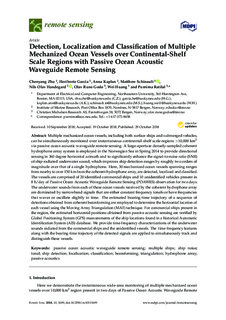| dc.contributor.author | Zhu, Chenyang | |
| dc.contributor.author | Garcia, Heriberto | |
| dc.contributor.author | Kaplan, Anna | |
| dc.contributor.author | Schinault, Matthew | |
| dc.contributor.author | Handegard, Nils Olav | |
| dc.contributor.author | Godø, Olav Rune | |
| dc.contributor.author | Huang, Wei | |
| dc.contributor.author | Ratilal, Purnima | |
| dc.date.accessioned | 2018-11-09T11:17:16Z | |
| dc.date.available | 2018-11-09T11:17:16Z | |
| dc.date.created | 2018-11-07T12:31:54Z | |
| dc.date.issued | 2018 | |
| dc.identifier.citation | Remote Sensing. 2018, 10 (1699), . | nb_NO |
| dc.identifier.issn | 2072-4292 | |
| dc.identifier.uri | http://hdl.handle.net/11250/2571777 | |
| dc.description.abstract | Multiple mechanized ocean vessels, including both surface ships and submerged vehicles, can be simultaneously monitored over instantaneous continental-shelf scale regions >10,000 km 2 via passive ocean acoustic waveguide remote sensing. A large-aperture densely-sampled coherent hydrophone array system is employed in the Norwegian Sea in Spring 2014 to provide directional sensing in 360 degree horizontal azimuth and to significantly enhance the signal-to-noise ratio (SNR) of ship-radiated underwater sound, which improves ship detection ranges by roughly two orders of magnitude over that of a single hydrophone. Here, 30 mechanized ocean vessels spanning ranges from nearby to over 150 km from the coherent hydrophone array, are detected, localized and classified. The vessels are comprised of 20 identified commercial ships and 10 unidentified vehicles present in 8 h/day of Passive Ocean Acoustic Waveguide Remote Sensing (POAWRS) observation for two days. The underwater sounds from each of these ocean vessels received by the coherent hydrophone array are dominated by narrowband signals that are either constant frequency tonals or have frequencies that waver or oscillate slightly in time. The estimated bearing-time trajectory of a sequence of detections obtained from coherent beamforming are employed to determine the horizontal location of each vessel using the Moving Array Triangulation (MAT) technique. For commercial ships present in the region, the estimated horizontal positions obtained from passive acoustic sensing are verified by Global Positioning System (GPS) measurements of the ship locations found in a historical Automatic Identification System (AIS) database. We provide time-frequency characterizations of the underwater sounds radiated from the commercial ships and the unidentified vessels. The time-frequency features along with the bearing-time trajectory of the detected signals are applied to simultaneously track and distinguish these vessels. | nb_NO |
| dc.language.iso | eng | nb_NO |
| dc.title | Detection, Localization and Classification of Multiple Mechanized Ocean Vessels over Continental-Shelf Scale Regions with Passive Ocean Acoustic Waveguide Remote Sensing | nb_NO |
| dc.title.alternative | Detection, Localization and Classification of Multiple Mechanized Ocean Vessels over Continental-Shelf Scale Regions with Passive Ocean Acoustic Waveguide Remote Sensing | nb_NO |
| dc.type | Journal article | nb_NO |
| dc.type | Peer reviewed | nb_NO |
| dc.description.version | publishedVersion | nb_NO |
| dc.source.pagenumber | 26 | nb_NO |
| dc.source.volume | 10 | nb_NO |
| dc.source.journal | Remote Sensing | nb_NO |
| dc.source.issue | 1699 | nb_NO |
| dc.identifier.doi | 10.3390/rs10111699 | |
| dc.identifier.cristin | 1627906 | |
| cristin.unitcode | 7431,19,0,0 | |
| cristin.unitname | Marin økosystemakustikk | |
| cristin.ispublished | true | |
| cristin.fulltext | original | |
| cristin.qualitycode | 1 | |
